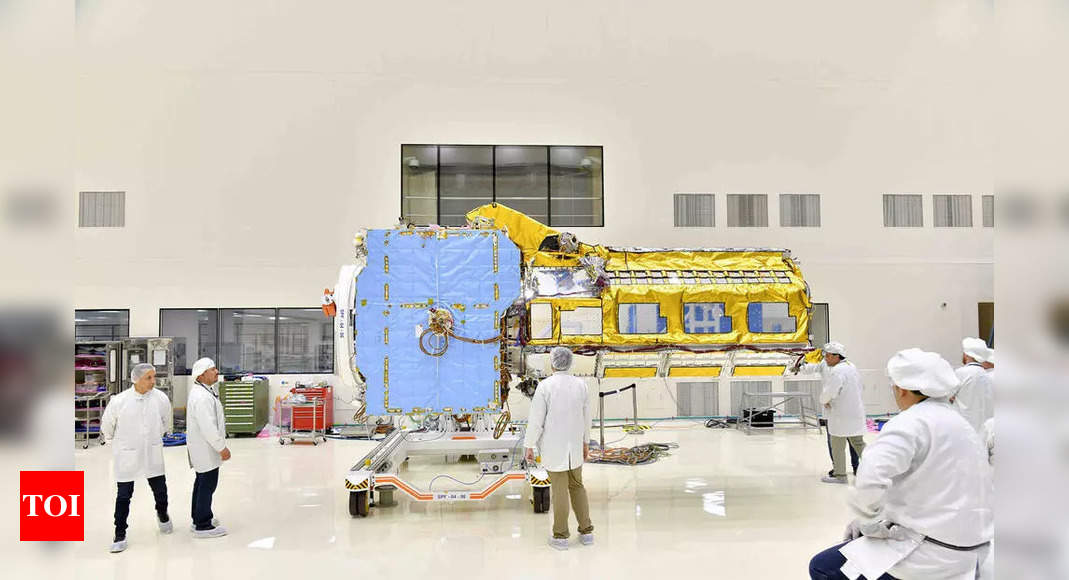[ad_1]
NEW DELHI: The NISAR satellite has reached a significant milestone as its two major components have been integrated to form a single spacecraft in Bengaluru, the US space agency NASA has said in a release.
According to NASA, In June, engineers successfully united the spacecraft bus and radar instrument payload of the NISAR satellite in a clean room at the ISRO facility in Bengaluru. The payload had been transported from NASA’s Jet Propulsion Laboratory (JPL) in Southern California earlier in March, while the spacecraft bus was constructed at the ISRO facility.
The satellite’s cylindrical radar instrument payload contains two radar systems and is about the size of an SUV and partially wrapped in gold-coloured thermal blanketing. The S-band radar is particularly useful for monitoring crop structure and the roughness of land and ice surfaces, while the L-band instrument can penetrate denser forest canopies to study the woody trunks of trees, among other observables, the release added.
The wavelengths of the S-band and L-band signals are about 4 inches (10 centimetres) and 10 inches (25 centimetres), respectively, and both sensors have the potential to see through clouds and collect data day and night.
NISAR, a collaborative project between NASA and the Indian Space Research Organisation (ISRO), stands for NASA-ISRO Synthetic Aperture Radar. This advanced satellite is designed to track the movements of Earth’s land and ice surfaces with exceptional precision.
The NISAR satellite is scheduled for launch in early 2024.
“As NISAR monitors nearly every part of our planet at least once every 12 days, the satellite will also help scientists understand, among other observables, the dynamics of forests, wetlands, and agricultural lands,” the NASA said in its release.
Currently, the NISAR satellite is undergoing performance testing, which will be followed by rigorous environmental testing to ensure its readiness for launch and its ability to meet operational requirements in orbit. Subsequently, it will be transported approximately 220 miles (350 kilometers) eastward to the Satish Dhawan Space Centre, where it will be integrated into its launch fairing and placed atop ISRO’s Geosynchronous Satellite Launch Vehicle Mark II rocket for deployment into low Earth orbit.
(With inputs from agencies)
According to NASA, In June, engineers successfully united the spacecraft bus and radar instrument payload of the NISAR satellite in a clean room at the ISRO facility in Bengaluru. The payload had been transported from NASA’s Jet Propulsion Laboratory (JPL) in Southern California earlier in March, while the spacecraft bus was constructed at the ISRO facility.
The satellite’s cylindrical radar instrument payload contains two radar systems and is about the size of an SUV and partially wrapped in gold-coloured thermal blanketing. The S-band radar is particularly useful for monitoring crop structure and the roughness of land and ice surfaces, while the L-band instrument can penetrate denser forest canopies to study the woody trunks of trees, among other observables, the release added.
The wavelengths of the S-band and L-band signals are about 4 inches (10 centimetres) and 10 inches (25 centimetres), respectively, and both sensors have the potential to see through clouds and collect data day and night.
NISAR, a collaborative project between NASA and the Indian Space Research Organisation (ISRO), stands for NASA-ISRO Synthetic Aperture Radar. This advanced satellite is designed to track the movements of Earth’s land and ice surfaces with exceptional precision.
The NISAR satellite is scheduled for launch in early 2024.
“As NISAR monitors nearly every part of our planet at least once every 12 days, the satellite will also help scientists understand, among other observables, the dynamics of forests, wetlands, and agricultural lands,” the NASA said in its release.
Currently, the NISAR satellite is undergoing performance testing, which will be followed by rigorous environmental testing to ensure its readiness for launch and its ability to meet operational requirements in orbit. Subsequently, it will be transported approximately 220 miles (350 kilometers) eastward to the Satish Dhawan Space Centre, where it will be integrated into its launch fairing and placed atop ISRO’s Geosynchronous Satellite Launch Vehicle Mark II rocket for deployment into low Earth orbit.
(With inputs from agencies)
[ad_2]
Source link











More Stories
Congress replaces Kamal Nath, names an OBC as Madhya Pradesh chief | India News
Fire breaks out in ITBP camp in Srinagar; none hurt | India News
Parliament Security: Co-villagers give clean chit to Lalit Jha, parents to move court | India News